This London Craft Week, we have the pleasure of hosting FIVE Collective in our Chelsea showroom. They’re a group of craftspeople working with silver and metal in a way that honours the rich history of the materials, while recasting them in contemporary terms. We connected with FIVE over a shared admiration for metal and the unique opportunities and challenges it presents. It’s full of intriguing contradictions: strong, rigid, and utilitarian, while simultaneously precious, malleable, and refined. This protean material fuels us to push the boundaries of creativity while working with age-old techniques.
We’ll be exhibiting FIVE’s work in our Chelsea showroom from 9th – 14th May alongside our own metal furniture. We hope you’ll stop by to say hello and admire their captivating creations. We also welcome you to join us for a conversation between Tom and FIVE’s Ane Christensen on 12th May where you can learn more about the many forms of this enduringly beautiful material, from delicate silver vessels to striking bronze tables. Tickets are available via London Craft Week.
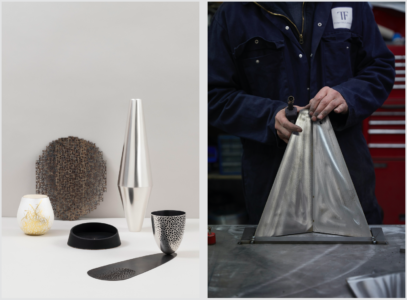
A selection of works by members of FIVE Collective; photographed by Nicola Tree (left) and our Echo Console Table in progress (right)
To offer a taste of what’s to come, we connected with FIVE to discuss what fuels their work. Read on to learn more about their practice and their vision of contemporary craft…
How did FIVE Collective start? What drew the group together?
Jessica: FIVE began as a conversation between a few of us about our industry and the possible opportunities after the pandemic. It was extremely important for us to remain active and keep modern silver and metal relevant to the current craft scene at such a time. We thought collectively we were able to make a bigger impact, which we did in the end.
Patrick: Five grew out of a collective ambition to re-examine the exhibiting of silversmithing and fine metal work, finding new avenues, opportunities, and methods for showing work to an audience. In this process, this greater ambition further supports the creation of new and ambitious work.
Sheng: One of the reasons we formed this new collective was to fill a gap we noticed at art fairs, where we found silversmithing to be underrepresented and often lost amongst a larger stand of other crafts and practices. We not only want to be able to tell a strong story about our work and fully realise how it is intended to be shown, but also to attract a wider interest in our craft, inspiring and enthusing the next generation.
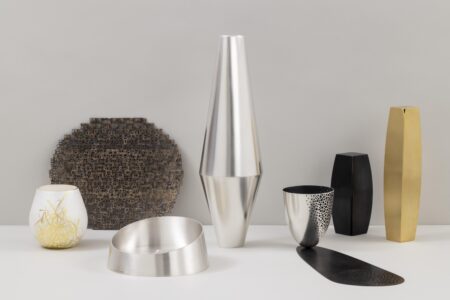
A selection of works by members of FIVE Collective; photographed by Nicola Tree
Is there a common thread that runs through all of your work?
Jessica: The group is a diverse mix of exciting emerging and established makers that represent a cross-section of generations and backgrounds with a shared ethos of creativity revolving around precision and fine craftsmanship.
Ane: Within the group, all our work sits very well together whilst allowing space for our individual voices. I believe we all use our deep knowledge of traditional craftsmanship to reinterpret both functional and abstract objects in contemporary ways.
Angela: Craftsmanship is at the heart of our work. Making well and pushing at the technical possibilities of our craft is as important as challenging what silver and metal objects can be. We are all interested in creating dramatic larger scale work for all environments and reimagining the surface spaces they can inhabit. We set up FIVE so we could start creating more exciting conversations in silver and metal and opening up wider opportunities for our craft.
Sheng: Though our styles of work and methods of making vary, we come together to apply contemporary ideas to traditional materials and techniques, challenging the preconceptions and expectations around our materials – their tradition, value, and function.
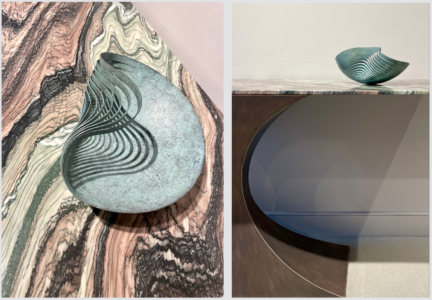
Ane Christensen’s ‘Dented Bowl’ in Verdigris copper on our Capricorn Console Table in Rose Pewter with a Rosso Luana marble top
What initially attracted you to working with metals?
Jessica: I’ve always been drawn to working with metal, particularly silver. There is something about its malleability and strength that allows me to push the boundaries of the material and create all sorts of different forms.
Patrick: I was drawn to the techniques and technical challenges involved. I had no prior knowledge of metalworking before I studied it, aside from making a gardening trowel at school. I was also drawn to the scale of jewellery and silverware, being neither microscopic nor monumental, but a very accessible scale that welcomed intricate detail whilst still celebrating formal experimentation. I have enjoyed working with mixed metals techniques, combining different metals and alloys together in order to find a new material for me to work with. This has not relied on a singular technique or method, but rather encouraged a constant searching for alternative ways to bring metals together and enjoy the surprising aesthetics this generates.
Ane: Though I have always been a maker, it took me a while to find my material. As a teenager I came across some scrap copper and I’m still exploring over 30 years later. To me, metal is the most complex of materials. It is never forgiving. There is never a short cut. However, I could not work in any other material. I will never finish exploring its possibilities. I just love its contradictions: how it can be both incredibly precious and in a scrap yard; both densely thick and almost lace-like; both inky dark and brightly reflective; both incredibly precise and organically fluid.
Angela: I love the permanence of metal, how it can be pushed, formed, bent, and assembled into objects and tableware. The processes of silversmithing are very transformative. You start with simple materials that you need to fashion and change with your skill and knowledge, using age-old techniques to work them into your desired forms. I feel very fortunate to have this talent and the opportunity to create and visualise my craft in my own unique way.
Sheng: I had been trained as a jeweller when I first entered the China University of Geosciences in 2012 and used metal as my main material. After experimenting with various materials over the course of my studies, I realised working with metal – especially silver – was something I truly enjoyed and my fascination with it grew.
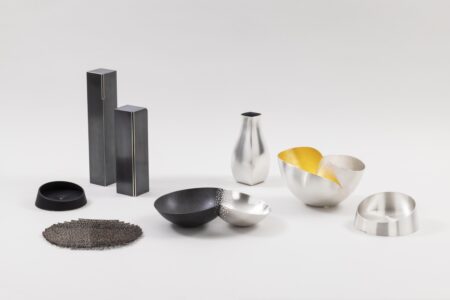
A selection of works by members of FIVE Collective; photographed by Nicola Tree
How would you describe your design ethos?
Jessica: Capturing the essence of form through the gesture of line.
Patrick: I have often experimented with techniques and processes, keeping an eye on the aesthetic impact of the result and then using these as guides for a final form or object. I am naturally drawn to fairly familiar or accessible styles and shapes, but welcome the challenge to stretch beyond this, often being drawn to aesthetics far outside of my usual contact, hoping to understand, or at least enjoy them, better.
Angela: Pared back and elegant. I love contrasting smooth and tactile surfaces with crisp and clean edges and if pushed to sum up my design ethos, I would say I aim to make work that both visually excites and challenges our idea about what is possible.
Sheng: My work is usually influenced and inspired by minimalist art, contemporary architecture, and geometrical form. It touches on the notions of boundary, volume, silhouette, capacity, shadow, and subtle detail. Through my vessels and containers, I explore the connection of internal and external as well as positive and negative space. My work demonstrates a minimalist aesthetic, purity of visual language, and an ethos of moderation. I am constantly questioning the relationship between the work and its surroundings as well as the role of function in a conceptual and aesthetically geared work of art.
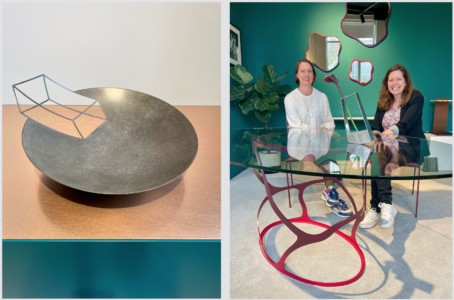
Metal bowl by Ane Christensen on our Balzac Side Table in Green with a Dull Polished Bronze top (left) and Angela and Ane in our showroom with Angela’s silver vase
Is there a major difference in how you approach art objects versus functional pieces?
Patrick: Functional work has to work well; part of its enjoyment is a pleasure in its use. Art objects need to satisfy the instincts developed from looking at art, sometimes which is a satisfying familiarity, enjoying an aesthetic that I know I like, but also finding something new and being encouraged to explore a new visual path.
Ane: Absolutely not. I approach all my work in the same way, whether abstract or functional. The sculptural quality and the expression of each piece of work is what drives me.
Angela: I apply the same ethos to making all of my pieces. I work precisely in every way, from forming to finishing the surface, which I do mostly by hand rather than machine, in order to apply my own surfaces and retain the crisp lines and edges of the metal. The design must also be ‘fit for purpose’. If it’s to function it must do that well; if it’s to sculpturally excite and push at the expectations of what’s possible, then it will be carefully worked. Everything I make is done with care and consideration.
Sheng: I think the major difference would be the starting point and purpose of designing and making. Many of my previous works are concept-based and I could simply concentrate on the work itself and tell a story or express an idea through it. Whereas a functional piece starts from the practical use of the work and how the design can effectively serve its function. Lately, I have been paying more attention to functionality and trying to strike a balance between the artistic and the commercial.
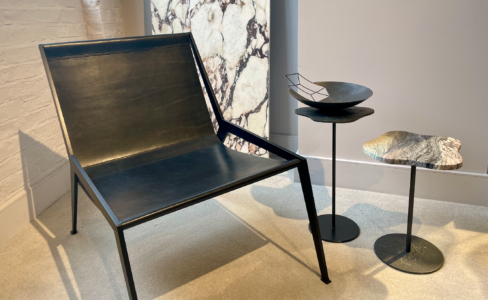
Metal bowl by Ane Christensen with our Lily Side Tables with Moon metal and Rosso Luana marble tops + Berlin Easy Chair in Charcoal with black bridle leather
Do you find the UK to be a vibrant environment for craft? What has your experience as a contemporary craftsperson been like here?
Jessica: The UK is an extremely vibrant environment for craft. It’s not just a great scene for craft but it’s also got a wonderfully supportive environment and community of people.
Patrick: My experience is that the UK has a very well established and understood craft scene. The quality of the making is extremely high across many fields. Regarding silver and fine metal, it is potentially some of the best in the world. It also offers a broad spectrum of styles across the mediums, with a range of styles appreciated. There is encouragement and critique from the academic institutions developing new avenues and directions for crafts as well as honoring the values and importance in a solid understanding of skill and the impact of working materials. There also seems to be an appreciative audience and most people I meet respect and are interested in making of any kind.
Angela: The craft scene in the UK is very strong and established. I trained at some of the best institutions, including Bishopsland and the Royal College of Art and have been part of leading the association, Contemporary British Silversmiths, which is a vibrant and diverse network of the best makers and designers working in this country. We also have some amazing opportunities for showcasing our work including Collect Art Fair and Goldsmiths’ Fair, which is well known as the premier destination for enjoying the best of jewellery and silverware in the country. We are extremely fortunate.
Sheng: The appreciation of craft is rooted in the UK’s history and it is still vibrant nowadays as there are loads of opportunities to exhibit, as well as a cast of supporting structures. Competitions, bursaries, and scholarships help to lift makers up and give them a platform. I’ve had the honour of winning a few, like the Silver Award from The Goldsmiths’ Crafts and Design Council. The Victoria and Albert Museum is also very supportive of makers and has taken my work into their permanent collection, demonstrating a commitment to safeguarding the craft.
Interview with FIVE Collective: Ane Christensen, Angela Cork, Jessica Jue, Patrick Davidson, and Sheng Zhang by Annabel Colterjohn